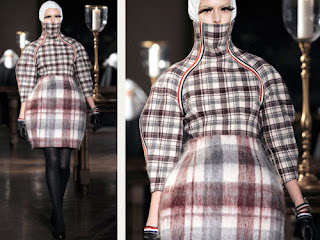The earliest types of corsets, worn from the 16th to 18th century, were designed to transform the upper torso into a very stiff, inverted cone shape. Very tough materials such as boning were used to create this desired effect. The bones are sewn vertically into the fabric of a corset or bodice. At this time, boning would also have been used in the making of cage underskirts.
These costumes worn by Queen Elizabeth during the Elizabethan era are good examples of boning. Boning was used here in the bodice of the dress to cinch in the waist, creating an inverted conical effect. Boning was also used in the cage underskirt of the dress to create a voluptuous skirt that exaggerated the hips and made the waist seem all the more miniature;
 |
| 1860's court dress, Victoria & Albert Museum. |
Many contemporary designers still incorporate the boning technique into their garments to create shapes forming off the body.
Thom Browne Autumn/Winter Paris 2011: The shapes forming off the body below are achieved through boning;
 |
| Here the skeleton of boning is shown as a decorative feature in itself, not merely as an internal structure. |
Una Burke: boning, exposed;
Richard Nicoll Spring/Summer 2012: tube dresses with boned rings;
Nicole Farhi ready-to-wear Spring 2012: she used boning to lend a petal shape to pleated skirts, and gave otherwise simple dresses a sculptural aspect to do the same;
Boning: Alien ad campaign 2009: Thierry Mulger
 |
| Boned corset |
 |
| Boning: Valerie Von Kittlitz |
 |
| Mary Katrantzou used boning in her skirts to give them a bulbous shape. Autumn/Winter 2011/12 |
 |
| Boning: Valentino Autumn/Winter 2010/11 |













.jpg)





Hi, you credit me in one of your pics but that is not my work.
ReplyDelete